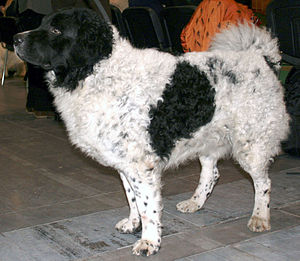Wetterhoun
| Wetterhoun (Frisian Water Dog) |
||
|---|---|---|
|
|
||
| FCI Standard No. 221 | ||
|
||
| Origin : | ||
| Alternative names: |
Wetterhond |
|
| Withers height: |
Male: ideally 59 cm. |
|
| Weight: |
not specified |
|
| List of domestic dogs | ||
The Wetterhoun or Frisian Water Dog is a Dutch dog breed recognized by the FCI ( No. 221, Gr. 8, Sec. 3 ) .
Origin and history
The Wetterhoun is a water dog in the classic sense. “Weather” is the West Frisian word for water. Dogs similar to the Wetterhoun were already kept as court dogs in the Middle Ages . Here he served as a watch dog , which also kept the vermin away from the yard. Presumably it goes back to much older water dogs, starting with the Portuguese water dog . Another line of ancestry points to Eastern Europe , the Curly Coated Retriever is said to be one of its direct ancestors. Both explain its curly, Persian-like fur. The closest relationship exists to the second Frisian breed, the Stabyhoun .
The Wetterhoun was almost extinct in the 1950s. A Frisian woman who had a Wetterhoun in her youth looked for living Wetterhouns in a newspaper advertisement. Thereupon some farmers reported, some of whom also had mixed breeds from Stabijs and Wetters. The current population was rebuilt from these dogs. There are currently around 800 dogs worldwide, most of which live in the Netherlands. There are around 80 dogs in Finland, 40 in France and 11 in Germany. The Nederlandse Vereiniging voor Stabij en Wetterhoun is responsible for breeding. The association wants to maintain the tradition and therefore pays great attention to the fact that the breeding regulations are adhered to.
description
The striking thing about the Wetterhoun, which is up to 59 cm tall, is its Persian-like curly coat, the hair is half-length and the curls are very close to the body, it is slightly oily, so it is ideal for long-term work in the water. The most common colors are black and white and brown and white. The head is strong and the ears are on the sides of the head. The tail is curled, carried upright on the back. The Wetterhoun should be built strong and straight angled (square).
Essence
Very robust, dog with "its own character", it is reserved towards strangers, friendly and reliable towards its caregivers. The character is described in German literature as stubborn or stubborn; this error is explained by the translation of the Dutch word “stoer”, which here means brave and resilient.
He is easy to train, but it requires consistency and a sensitivity for this breed. Repetitions bore him quickly, but he is very happy to work on things that inspire him (fetching, searching, rummaging). The Wetterhoun is very vigilant.
use
He was trained to hunt otters and polecats . Around 1900 the Wetterhouns were also used for mole hunting. Mole fur was then a commodity. Dogs of stature were used as cart dogs . Even today sometimes, he has the task under the dike maintenance , muskrats to catch. Most of the time, however, he continues to serve as a yard and guard dog.
